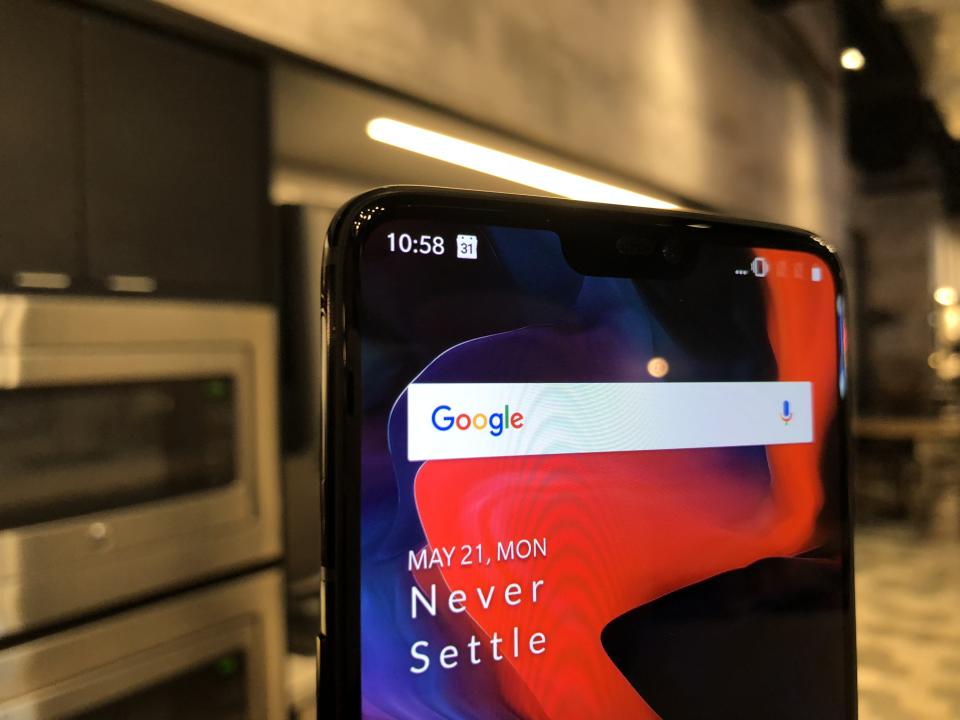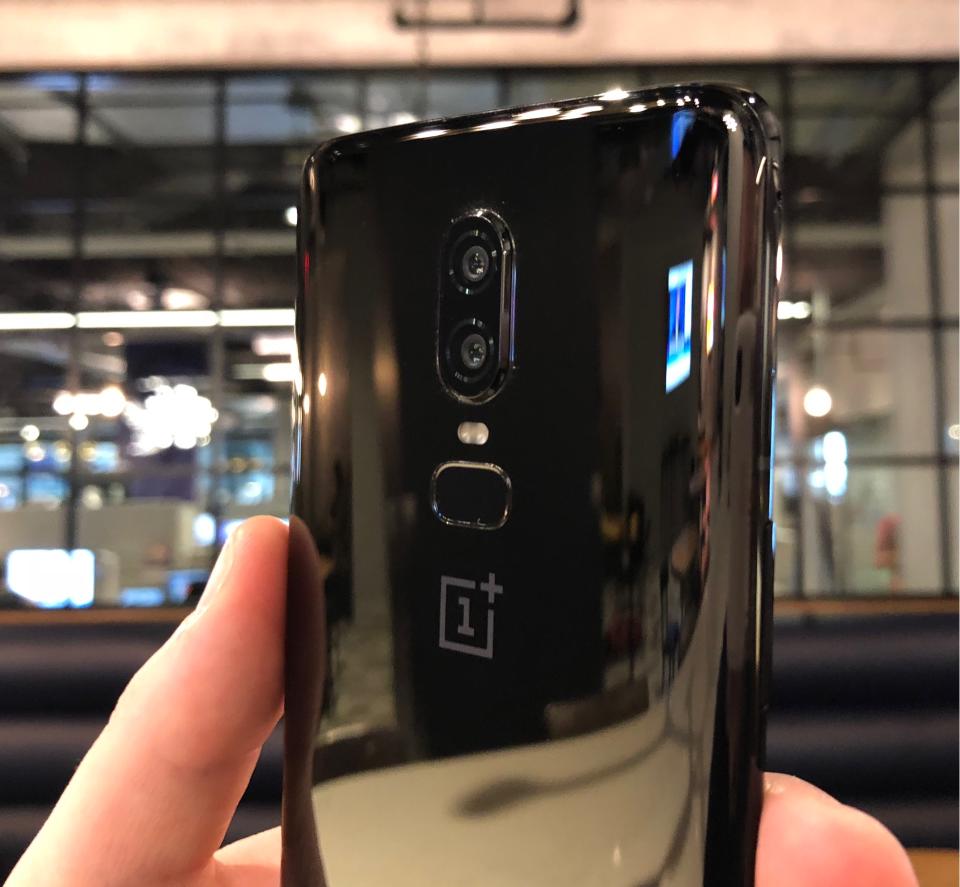OnePlus 6 review: A killer smartphone at a killer price
When it comes to Android smartphones, there’s Samsung’s Galaxy’s line of handsets, and a long list of also-rans. But those non-Samsung devices aren’t any less impressive than the Korean giant’s offerings. In fact, some eclipse Samsung’s products.
Take OnePlus, for example. The Chinese smartphone maker has been producing incredibly powerful handsets that easily match Samsung’s for years. For its latest trick, the OnePlus 6, OnePlus is pushing the envelope even further, stretching its phone’s display to a massive 6.3 inches, packing an improved camera and still maintaining OnePlus’s signature low price, $529 for a base model.
It’s a fantastic device that should definitely be on your short list of handsets to buy.
Top-notch design
The OnePlus 6 is the follow-up to last year’s OnePlus 5T. The two devices are roughly the same size, but the 6 packs a 6.3-inch display, while the 5T had a 6-inch screen. OnePlus added that extra bit of real estate by pushing the 6’s panel about as close to the handset’s edges as possible.
And to do that, the company has added a notch to its top bezel. That’s right, the infamous notch that everyone talked about with the launch of the iPhone X is here on the OnePlus 6, too. And like the iPhone’s notch, the 6’s … isn’t really a big deal.

Some users might find it slightly off-putting, but I haven’t found it to be an issue. OnePlus’s notch works well, because it simply separates notifications and the battery life and Wi-Fi status in the notifications bar. Even when watching movies, I didn’t find the notch to be intrusive. Games like “PlayerUnknown’s BattleGrounds Mobile” fit nicely within the screen without the notch having any impact on them.
The 6’s panel uses AMOLED display technology, which makes for rich colors and deep blacks. Unlike other big-screen smartphones, however, the 6 has a 1080p display resolution. The S9 and Google’s (GOOG, GOOGL) Pixel 2 XL, meanwhile, both have higher resolution screens. You’re really unlikely to notice the difference though unless you’re using your phone for VR.
Class in glass
While the OnePlus 6 is the same size as the 5T and shares its general design, OnePlus differentiates its latest handset by trading in its old metal unibody design for an all-glass aesthetic. Samsung’s Galaxy S9 and Apple’s (AAPL) iPhone X, 8 and 8 Plus all have glass back designs, too.
OnePlus is offering three colors of the 6 including the mirror black, which has a traditional glass look, as well as midnight black and silk white. What’s impressive is that neither the midnight black nor silk white models actually look like they’re made using a glass back. To pull this off, OnePlus uses a corrosion technique on the midnight black model to make it look more like ceramic, while the company uses pearl powder to give the silk white version a more matte styling.

Up front, you’ll notice the OnePlus has no room for traditional Android interface buttons like back, Home and recent apps. Instead, you can either use on-screen buttons, or, in a move taken straight out of Apple’s playbook — as well as Google’s upcoming Android P update — use gestures to navigate between apps.
Like the iPhone X, you can swipe up from the bottom of the screen on the 6 to go back to the Home screen and swipe up and hold to pull up recent apps. To navigate back, you simply swipe up on the left or right side of the screen. It takes a hot second to get used to, but it opens up more of the screen since you’re not taking up space with those virtual buttons.
Camera
OnePlus packed the 6 with two rear cameras. The main camera is a 16-megapixel model for normal shooting and a 20-MP model. Compared to the iPhone 8 and the Galaxy S9, the OnePlus 6 offered the most accurate image coloring, but fine details in certain shots weren’t quite as sharp as those taken with the iPhone or S9. Interestingly, the iPhone’s camera tended to oversaturate images — making them look unrealistic. The S9’s shots looked a bit duller.

The OnePlus, however, struggled in low-light settings. Photos took far too long to shoot, with the flash staying on for what felt like a few second. Images also looked washed out. The iPhone’s flash is still among the best out there, outpacing both the S9 and OnePlus.

The 6 was far better at taking low-light photos without the flash, but even then it couldn’t keep up with the iPhone 8. Samsung’s S9 made subjects look as though they were artificially smoothed out.
Need for speed
All OnePlus 6 models pack 8-core Qualcomm Snapdragon 845 processors, which offers plenty of firepower for your everyday tasks. The base version of the 6 includes 6GB of RAM and 64GB of storage space. That should be more than enough for most users.
If you feel a real need for speed, though, you can opt for a OnePlus 6 with 8GB of RAM and 128GB of storage. And if you just want to max out your device, you can get one with 8GB of RAM and 256GB of storage.

My OnePlus 6 review unit came with 8GB of RAM and handled games like “PlayerUnknown’s BattleGrounds Mobile” with ease. Levels loaded quickly and the action was nice and fluid.
In terms of battery life, the OnePlus 6 lasted all day without needing a charge. I naturally plugged it in at night before hitting the sack, but I still had plenty of juice left. OnePlus also includes its fast charger in the box, which fills the handset up in no time. OnePlus says you can get a full day’s worth of power from a 30-minute charge.
Software and price
The OnePlus 6’s main selling point is its price. At $529 for a version with 6GB of RAM and 64GB of storage, the OnePlus 6 undercuts both Samsung’s S9 ($719) and the iPhone 8 ($699). Even if you bump the handset up to the top-of-the-line model with 8GB of RAM and 256GB of storage, you’ll still pay just $629.
It’s not just the phone’s pricing, though. OnePlus also uses its own version of Google’s Android operating system called OxygenOS. Essentially, it’s a more customizable version of Android, which itself is already more customizable than Apple’s iOS. This is the kind of phone people who really want to make their handset their own will want.
Should you get it?
The OnePlus 6 is a fantastic smartphone at a ridiculously low price. Its display is beautiful, its design is chic and its performance is top notch. The phone’s camera might not be the best around, but it still captures solid photos.
If you’re looking for an inexpensive Android smartphone with all of the bells and whistles out there, then the OnePlus 6 is the handset to go for.
More from Dan:
Apple CEO Tim Cook brings up data privacy in Duke graduation speech
Warren Buffett: ‘Cyber is uncharted territory and it’s going to get worse, not better’
This is the closest you can get to a ‘Star Wars’-style lightsaber battle
Email Daniel Howley at [email protected]; follow him on Twitter at @DanielHowley. Follow Yahoo Finance on Facebook, Twitter, Instagram, and LinkedIn
